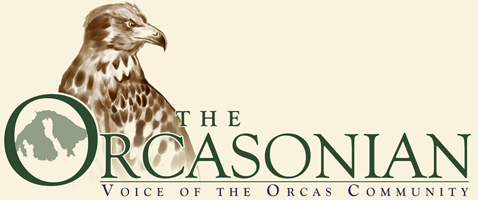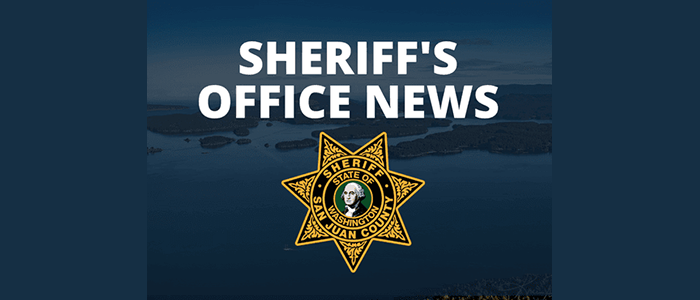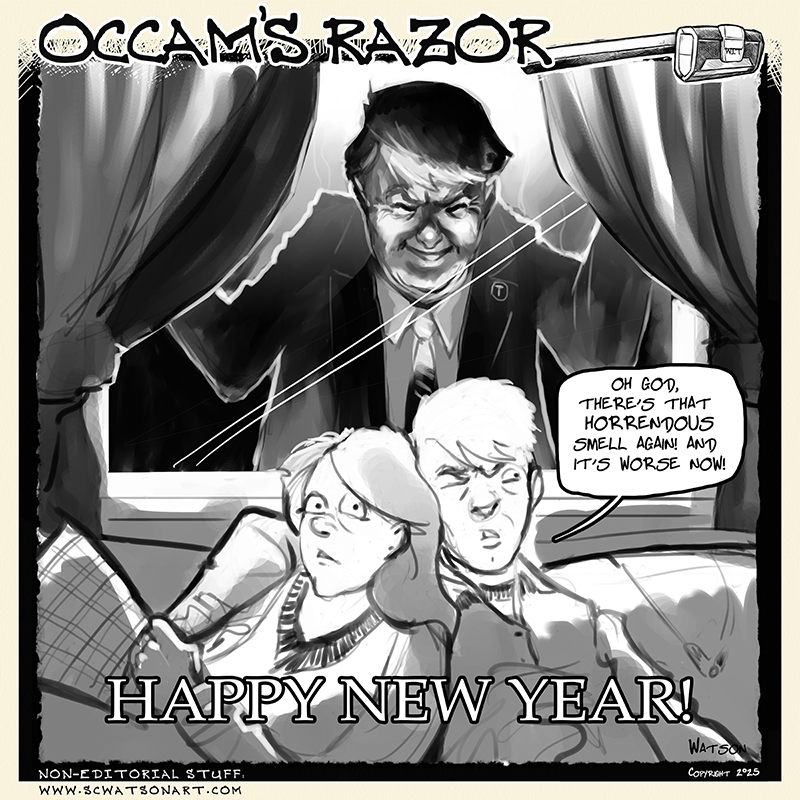— a semi-regular humor column by Maurice Austin —
Several years ago, working an incoming tide off Open Bay for pinks, motoring up and drifting back down, my buddy and I became aware that orcas might be coming, not because we saw a fin or breach or spout or spy-hop, but because suddenly we were hemmed in to our drift by whale-watch boats large and small, the paparazzi entourage that tails the whales and then rushes ahead to set up alongside their path, and also there was a helicopter.
“Well shoot,” said my buddy, except “shoot” wasn’t exactly what he said. We reeled in and bobbed, motor off, waiting for the orcas and the paparazzi to pass. I don’t have a large boat—just a little 16’ Campion center-console, a fishing platform at best. It can be intimidating on the bob—particularly when a larger boat comes unsettlingly close, like the triple-decker still under power that cut right in front of us, a guy on deck still furtively hucking a 3” pink buzz bomb at the imagined humpies starboard. I resisted the urge to fire up and get out of there, at least until the whales passed. We broke out the cheese, salami, crackers.
Looking around, it was pretty clear the fishing community had gotten the memo. Everybody was bobbing, motors off, downrigger balls dangling right off their Scottys. But there was another element, the three-story element, the mega-yacht element, and of course the commercial whale-watching paparazzi, that didn’t seem to have received the memo. They were still in pursuit mode.
Out of this jam of bobbing fishing boats suddenly overtaken by motoring whale-watchers, a boat came racing up to us, just as the mega-yacht captain was turning in front of us, maybe finally realizing he’d cut off our drift, or maybe realizing suddenly there were whales about; whatever, he gunned it, right into the path of the oncoming whales, fins visible now and then among the bobbing fishermen. The boat that came racing up to us turned suddenly, a bullhorn was pointed at us, instructions given to shut down our motor, though we’d been bobbing for what—five minutes already? And right behind us, a three-story jerk powering his way into the whale’s course?
Anyway, my buddy yelled back, using several words that also weren’t “shoot.” Even pointed at obviously clueless mega-yacht as it narrowly passed another fishing boat that had shut down its engine.
It was as if the Soundwatch personnel that day had blinders on—they couldn’t see the mega-yacht, could only see us, probably the smallest boat out there that day. Not sure what attracted them to us, did we look the least expensive? Smallest? Most unlikely to argue? Wanted cheese and crackers and salami?
The bullhorn was raised again, instructions repeated, please shut down your motor, buddy started to laugh at this point, what the heck, here, I’ll turn the helm back and forth, look, we’re not under power, hands in the air, buddy pointing at mega-yacht as it enters the intercept zone, three Soundwatch crew glaring portholes into us as 15 degrees and 150 yards off their bow an enormous fin emerges among the whitish wake of the mega-yacht, still churning away.
But the Soundwatch boat came alongside, no bullhorn now, just a youngish guy telling us to shut down our motor, and we say we have, and point at the jerk in the yacht, look at that guy, but of course they don’t, just look at us, and tell us there are orca whales coming through, just wait a bit before firing up, buddy at this point about to explode, and not just from the rapid ingestion of half a stick of salami, quarter pound of cheese, two stacks of crackers.
The last time that the National Oceanic and Atmospheric Administration (NOAA) proposed a “no-go” zone off San Juan island in order to protect the whales, several user groups were noticeably exempt, including commercial traffic, commercial fishermen, and tribal boats. While it’s unclear whether such uneven regulations will be in place this time around, NOAA is again proposing a “no-go” zone, citing boat motor noise as a factor affecting whale foraging behavior.
The elephant in the room here is whale-watching tourist dollars, inasmuch as that entire industry relies of the pursuit (harassment?) of marine wildlife for spectator entertainment. Rather than trap whales and place them in aquariums, we bring the aquarium attendees to the whales, incessantly, in motorized vessels. And then there are tribal and commercial fishing dollars, a couple other elephants which would rather be able to purse-seine in peace, thank you very much, without all these pesky private citizens afloat about.
But NOAA’s proposal strikes particularly hollow this time around, given their recent permit bungling resulting from closed-door North of Falcon fishery co-manager negotiations, which resulted in the closure of many recreational fishing areas state-wide. Er…closure for non-tribal fisheries, anyway. And oh, you’re closed? We’ll take that “foregone opportunity” thanks, had permits in hand before the negotiations anyway, so what do we need you for? Nets went in while lines were kept out.
Perhaps what rankled most folks’ nerves the last time a “no-go zone” was proposed was the fact that the exclusion zone was not without exemptions, such that it became difficult to generate support among those prohibited from dropping a single barbless hook into the briny, while seiners could drop wall after wall of gillnet with impunity. Exclusion zone, my hiney: it’s a pay-to-play zone, for sale to the highest bidder, grumble grumble, the chant went on fishing-related boards across the state, hey look, a protection zone for tribal and commercial fishers, what a novel idea, state sure is looking out for its tax base with that one, so they’ll arrest kayakers off Lime Kiln in order to protect whales, while seiners pull, circle, pick away? Well, yep, that’s what it meant, last time around; what, think this time will be any different? Benjamins take precedence over the presence of any or other or all marine resources, in the eyes of some “co-managers,” some grumble and gripe.
Tickles me pink (no that’s not a pun, or at least not one with much punch) that others propose knocking down Columbia River system dams as a panacea to the nutritional needs of the orca population; sure it would help but then so would knocking down the dams on the Skagit, and eliminating the netting harvest of Chinook on the Stillaguamish, Nooksack, Samish, Skagit, Fraser, &c. Besides direct competition for Chinook, some of us bipedal hominids are in more or less direct competition against the orcas in other ways—from shoreline development, farming and logging impacts, point- and non-point pollution, alas, we’re just not able to completely minimize our presence, unless we get rid of it.
Sooner or later maybe it will be determined that the San Juan Islands are too precious to be populated by humans, and an eradication program proposed to reduce our numbers, pesky and defiling as we are, by what authority, after all, do we stick and un-stick our unworthy feet upon this soil, set our sails upon these waters, by what authority, I ask, if not the State’s? It will be a much less problematic world, citizens, when the waterways are free of privately-owned vessels, such that the commercial fishing and coal- and bitumen-laden barges can navigate and operate without interference or even notice, confined as we are to our fixed or mobile boxes, stay between the lines, please, ignore that Whitman poem, that Hemingway story, look, you have 143 Facebook notifications!
Your mileage may vary.
**If you are reading theOrcasonian for free, thank your fellow islanders. If you would like to support theOrcasonian CLICK HERE to set your modestly-priced, voluntary subscription. Otherwise, no worries; we’re happy to share with you.**









Well ranted, sir. Your last paragraph is probably – and sadly – prescient regarding the rosy future for large commercial interests.
Maurice, this is so incredibly well written and points so well taken. I’m really happy to see you’ll be doing it regularly. Look forward to your next article. BTW, what can we do about the problem?
Nice work, easily read. Spot-on observations. Kudos!